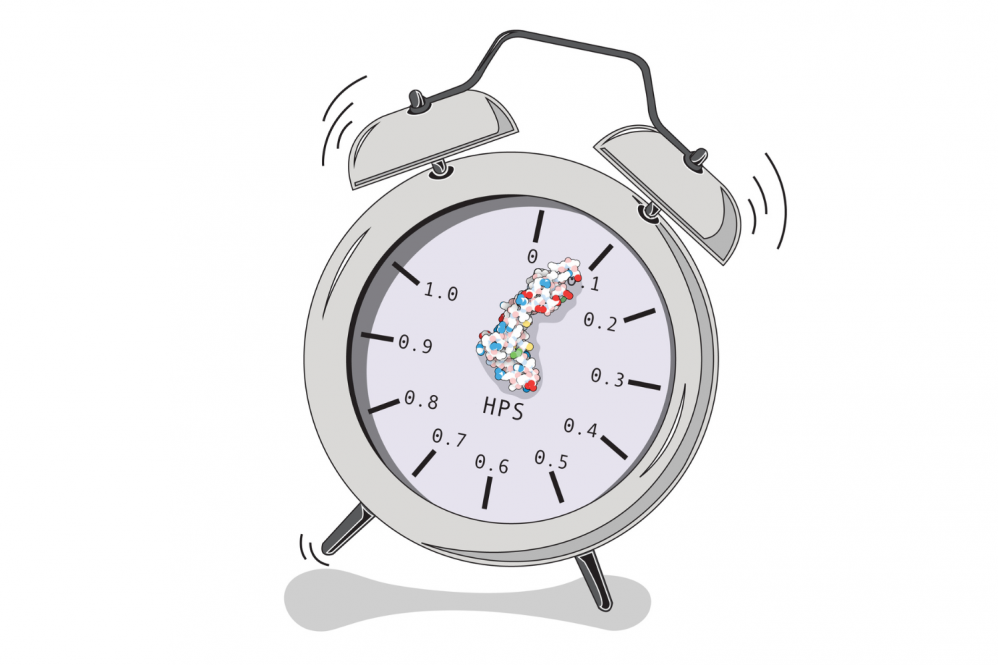UConn School of Medicine study published in PNAS introduces Healthspan Proteomic Score as a biomarker for healthy aging

Dr. Chia-Ling Kuo et al. demonstrate the Healthspan Proteomic Score (HPS), derived from chronological age and the expression levels of 86 proteins, is a strong predictor of disease and mortality risk. Lower HPS values are associated with higher risks of disease and mortality. Pictured is a "biological clock" representation hinting that proteins inform the HPS, which can inform our healthspan. Here, the clock's hand is a 3D rendering of growth/differentiation factor 15 (GDF15), a protein predictor of healthspan. Image credit: Bernard L. Cook III, PhD, who conceptualized, illustrated, and composed the final image, and Illustrate, the software used to render GDF15 (Goodsell DS, Autin L, Olson AJ (2019) Illustrate: Software for Biomolecular Illustration. Structure 27, 1716-1720).
A new study published in the Proceedings of the National Academy of Sciences (PNAS) presents a blood-based proteomic signature that predicts how long people are likely to live in good health-known as healthspan. The Healthspan Proteomic Score (HPS), developed by researchers at the UConn School of Medicine and collaborators at the University of Helsinki and the University of Exeter (UK), provides a powerful tool for understanding biological aging and assessing risks for a wide range of chronic diseases.
Using proteomic data from over 53,000 UK Biobank participants, the research team identified a panel of proteins that collectively signal a person's biological health. A lower HPS, determined based on the expression of these proteins, was significantly associated with a higher risk of mortality and age-related diseases, including heart failure, diabetes, dementia, and stroke-even after adjusting for chronological age and other health indicators. The score was validated in an independent Finnish cohort and demonstrated superior performance compared to existing measures of biological aging.
"Our findings underscore the importance of shifting the focus from lifespan to healthspan," says Dr. Chia-Ling Kuo, lead author and associate professor of Public Health Sciences at UConn School of Medicine and The Cato T. Laurencin Institute for Regenerative Engineering. "The HPS captures early biological changes in the body and may help inform interventions that promote healthier aging."
Dr. Breno S. Diniz, senior author and associate professor of Psychiatry at UConn School of Medicine and UConn Center on Aging, adds, "By integrating proteomic signals of biological aging, HPS offers a promising tool for identifying individuals at risk for age-related diseases and for guiding personalized prevention strategies."
Although aging is inevitable, this study team, as well as others, are increasingly learning that the pace of aging and how we each age are highly variable. The theme of the NIA-funded UConn Older Americans Independence Pepper Center is Precision Gerontology. This concept seeks to enhance independence in older adults by studying this heterogeneity. This research adds to growing evidence that aging biology can be measured and potentially modified, with the HPS offering a promising surrogate outcome for clinical trials of anti-aging therapies and preventive strategies aimed at extending years lived in good health; it marks an important step toward better predicting variability in aging trajectories and ultimately developing more targeted and effective interventions.
The research team is now working to evaluate the HPS in clinical trial settings. While it is not yet available for widespread use, this work lays critical groundwork for future tools that could help individuals and healthcare providers monitor and promote healthier aging.
This research was supported by the Claude D. Pepper Older Americans Independence Centers (OAIC) program (P30AG067988). Access to UK Biobank data was granted under application no. 92647, "Research to Inform the Field of Precision Gerontology" (PI: Richard H. Fortinsky, Ph.D., study co-author and professor at the UConn Center on Aging). The research team gratefully acknowledges the UK Biobank for providing data access and sincerely thanks the collaborators at the University of Helsinki for their replication efforts, as well as the UK Biobank participants for their invaluable contributions of time, health information, and biological samples that made this research possible.






